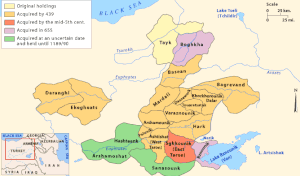This is an old revision of this page, as edited by 85.102.48.52 (talk) at 15:28, 29 January 2015. The present address (URL) is a permanent link to this revision, which may differ significantly from the current revision.
Revision as of 15:28, 29 January 2015 by 85.102.48.52 (talk)(diff) ← Previous revision | Latest revision (diff) | Newer revision → (diff)Template:Infobox Province TR The Tunceli Province (Kurdish: parêzgeh Dêrsim, Zazaki: Dêsim, Template:Lang-tr) formerly Dersim Province is a majority Alevi Zaza Kurdish with a minority Sunni Turkish population in the Eastern Anatolia region of Turkey. The province was named Dersim Province (Dersim vilayeti ), then demoted district (Dersim kazası ) and incorporated into Elâzığ Province in 1926. Finally it was changed to Tunceli Province on January 4, 1936. with the "Law on Administration of the Tunceli Province" (Tunceli Vilayetinin İdaresi Hakkında Kanun), no. 2884 of 25 December 1935. But some still call the region by this name. The capital city is Tunceli. The name of the provincial capital, Kalan, was then officially changed to match with the province's name.
Its adjacent provinces are Erzincan to the north and west, Elazığ to the south, and Bingöl to the east. The province covers an area of 7,774 km (3,002 sq mi) and has a population of 76,699. It has the lowest population density of any province in Turkey, just 9.8 inhabitants/km². Dersim is the only province of Turkey with an Alevi majority.
Tunceli is known for its old buildings such as the Çelebi Ağa Mosque, Sağman Mosque, Elti Hatun Mosque and adjoining Tomb and impressive natural scenery, especially in Munzur Valley National Park, the largest national park of Turkey.
Geography
Tunceli is traversed by the northeasterly line of equal latitude and longitude.
History
The history of the province stretches back to antiquity. It has been mentioned as 'Daranalis' by Ptolemy, and seemingly, it was referred to as 'Daranis' before him. One theory as to the origin of the name associates with the Persian Emperor Darius. Another, most likelly hypothesis (considering the region's armenian background), says the name Daranalis or Daranaghis comes from the historical armenian province of Daron, of which Dersim belonged.

The area that would become Dersim province formed part of Urartu, Media, the Achaemenid Empire, and the Greater Armenian region of Sophene. Sophene was later contested by the Roman and Parthian Empires and by their respective successors, the Byzantine and Sassanid Empires. Arabs invaded in the 7th century, and Seljuq Turks in the 11th.
As of the end of the 19th century, the region (called "Dersim") was included in the Ottoman sancak (subprovince) of Hozat, depending the city and the vilayet of Mamuret-ül Aziz (Elazığ today), with the exception of the actual district of Pülümür, which depended on the neighboring sancak of Erzincan, then a part of the Vilayet of Erzurum. This status continued through the first years of the Republic of Turkey, until 1936 when the name of the province ("Dersim") was changed to Tunceli, literally 'the land of bronze' in Turkish (tunç meaning 'bronze' and el (in this context) meaning 'land') after the Dersim Rebellion. The center of the province has been fixed in the town of Kalan and the district of Pülümür has been added within the boundaries of the new province.
Districts
Tunceli Province is divided into eight districts (capital district in bold):
Although a distinct province, Tunceli was administered from Elazığ until 1947.
Cities and towns
- Tunceli City 31,599 inh.
- Pertek City 11,869 inh.
- Hozat City 4,714 inh.
- Ovacık City 3,227 inh.
- Çemişgezek City 2,819 inh.
- Akpazar Town 1,769 inh.
- Mazgirt City 1,712 inh.
- Pülümür City 1,656 inh.
- Nazımiye City 1,636 inh.
Education
Ninety-eight percent of Tunceli's population has at least a primary school education, leading to one of the highest rates of literacy for a district within Turkey. In 1979/1980 Tunceli had the highest number of students attending universities as well as the top entry points until the only higher education school shut down and converted to a military base.
Tunceli University was established on May 22, 2008. It has departments in international relations, economics, environmental protection engineering, industrial engineering, electronic engineering, computer engineering and mechanical engineering.
References
- According to the "United Nations High Commissioner for Refugees (UNHCR)" Tunceli cannot be considered a purely Alevite region)
- Album of the Grand National Assembly of Turkey, Vol. 1, p. XXII, Dersim İli, 26.06.1926 tarih ve 404 sayılı Resmi Ceride'de yayımlanan 30.5.1926 tarih ve 877 sayılı Kanunla ilçeye dönüstürülerek Elazıg'a bağlanmıştır.
- Paul J. White, Primitive rebels or revolutionary modernizers?: the Kurdish national movement in Turkey, Zed Books, 2000, ISBN 978-1-85649-822-7, p. 80.
- New perspectives on Turkey, Issues 1-4, Simon's Rock of Bard College, 1999 p. 15.
- Victoria Arakelova, "The Zaza People as a New Ethno-Political Factor in the Region" - in – “Iran & the Caucasus: Research Papers from the Caucasian Centre for Iranian Studies, Yerevan”, vols.3-4, 1999-2000, pp. 197-408.
- G.S. Asatrian, N.Kh. Gevorgian. Zaza Miscellany: Notes on some Religious Customs and Institutions. – A Green Leaf: Papers in Honour of Prof. J. P. Asmussen (Acta Iranica - XII). Leiden, 1988, pp. 499-508
- Seyfi Cengiz Tarih (2005). History.
- Tunceli University Signs Protocol with 4 American Universities
External links
- Official Homepage of the Province Governor
- Official Homepage of the Culture and Tourism head office
- Official Homepage of the police head office
- Official Homepage of the Education head office
- Official Homepage of the health head office
- Education
| Tunceli Province of Turkey | ||
|---|---|---|
| Districts |  | |
| Metropolitan municipalities are bolded. | ||
39°12′53″N 39°28′17″E / 39.21472°N 39.47139°E / 39.21472; 39.47139
Categories: